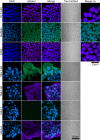Reprogramming Primary Amniotic Fluid and Membrane Cells to Pluripotency in Xeno-free Conditions
- PMID: 29286443
- PMCID: PMC5755485
- DOI: 10.3791/56003
Reprogramming Primary Amniotic Fluid and Membrane Cells to Pluripotency in Xeno-free Conditions
Abstract
Autologous cell-based therapies got a step closer to reality with the introduction of induced pluripotent stem cells. Fetal stem cells, such as amniotic fluid and membrane mesenchymal stem cells, represent a unique type of undifferentiated cells with promise in tissue engineering and for reprogramming into iPSC for future pediatric interventions and stem cell banking. The protocol presented here describes an optimized procedure for extracting and culturing primary amniotic fluid and membrane mesenchymal stem cells and generating episomal induced pluripotent stem cells from these cells in fully chemically defined culture conditions utilizing human recombinant vitronectin and the E8 medium. Characterization of the new lines by applying stringent methods - flow cytometry, confocal imaging, teratoma formation and transcriptional profiling - is also described. The newly generated lines express markers of embryonic stem cells - Oct3/4A, Nanog, Sox2, TRA-1-60, TRA-1-81, SSEA-4 - while being negative for the SSEA-1 marker. The stem cell lines form teratomas in scid-beige mice in 6-8 weeks and the teratomas contain tissues representative of all three germ layers. Transcriptional profiling of the lines by submitting global expression microarray data to a bioinformatic pluripotency assessment algorithm deemed all lines pluripotent and therefore, this approach is an attractive alternative to animal testing. The new iPSC lines can readily be used in downstream experiments involving the optimization of differentiation and tissue engineering.
References
-
- Takahashi K, Yamanaka S. Induction of pluripotent stem cells from mouse embryonic and adult fibroblast cultures by defined factors. Cell. 2006;126(4):663–676. - PubMed
-
- Yu J, et al. Induced Pluripotent Stem Cell Lines Derived from Human Somatic Cells. Science. 2007;318(5858):1917–1920. - PubMed
-
- Trounson A, DeWitt ND. Pluripotent stem cells progressing to the clinic. Nat. Rev. Mol. Cell Biol. 2016;17(3):194–200. - PubMed
-
- Schmidt D, et al. Prenatally fabricated autologous human living heart valves based on amniotic fluid derived progenitor cells as single cell source. Circulation. 2007;116(11 Suppl):I64–I70. - PubMed
-
- Weber B, Zeisberger SM, Hoerstrup SP. Prenatally harvested cells for cardiovascular tissue engineering: Fabrication of autologous implants prior to birth. Placenta. 2011;32:S316–S319. - PubMed
Publication types
MeSH terms
LinkOut - more resources
Full Text Sources
Other Literature Sources
Research Materials





